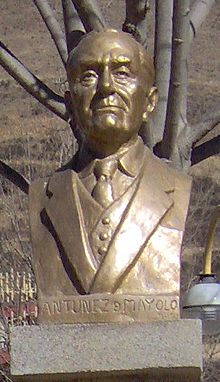You can help expand this article with text translated from the corresponding article in Spanish. (August 2012) Click for important translation instructions.
|

Santiago Antúnez de Mayolo was born on 10 January 1887 in the country estate of Vista Bella, province of Aija, Peru, department of Áncash. He was an engineer, physicist and mathematician.
Early years
He studied at Colegio Nacional de la Libertad (Huaraz) and later the College of Our Lady of Guadalupe (Lima), where he met Peruvian writer Abraham Valdelomar. In 1905 he was admitted into the Mathematical Sciences faculty of the San Marcos National University in Lima. At the end of the 1906 academic year (24 December), he received a distinction from President José Pardo, receiving a gold medal. After this, he traveled to France to get his degree in Electrical Engineering in the University of Grenoble. After that he took further studies at Columbia University. In 1912 he returned to Peru, where he worked as a professor at San Marcos University. After this he traveled around Peru, searching for suitable places to construct hydro-electric central power stations.
In the Third Pan-American Scientific Congress held in Lima, Antúnez de Mayolo presented the work "Hipótesis sobre la constitución de la materia," proposing the existence of a "neutral element" in the atom. Eight years later, Englishman James Chadwick confirmed this theory. In 1934, he proposed the existence of the positron in his article "Los tres elementos constitutivos de la materia." In 1936, David Anderson received the Nobel prize for its discovery.
References
- ^ El Dominical, Suplemento de "El Comercio" (26 April 2009). "El Nobel que no fue" (PDF). El Comercio. Retrieved 26 November 2018.
- ^ Valles F, Luis (April 2014). "¿Quién fue Santiago Antúnez de Mayolo?" [Who was Santiago Antúnez de Mayolo?]. Revista de la Sociedad Química del Perú (in Spanish). 80 (2): 144–145.
- Sociedad Nacional de Minería, Petróleo y Energía (2013). "Centrales Hidroeléctricas del Perú". Desde Adentro. 123: 24–28 – via Issu.
- Anonymous (2002). "Santiago Antúnez de Mayolo, precursor peruano de la Física Moderna". Editor. 2: 1 – via Sisbib UNMSM.
This article about a Peruvian scientist is a stub. You can help Misplaced Pages by expanding it. |